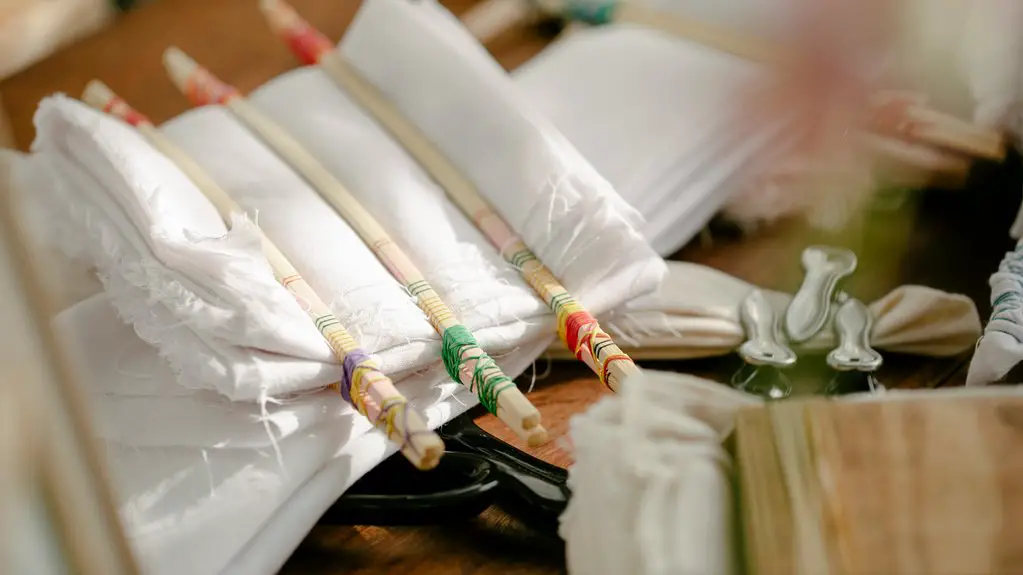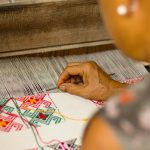Nui Shibori is a traditional Japanese stitched resist dyeing technique where you sew precise running stitches on fabric, then pull the threads tight to create gathers before dyeing. This creates intricate, textured patterns as the dye resists the stitched areas. You’ll need quality natural fabric, strong thread, and care with tension and dye selection for vibrant results. If you want to explore its rich history, detailed steps, and modern twists, there’s plenty more to uncover.
Table of Contents
Key Takeaways
- Nui Shibori is a traditional Japanese stitched resist dyeing technique from the Edo period using precise stitching to create intricate fabric patterns.
- The process involves sewing running stitches, pulling threads tightly to gather fabric folds, and dyeing to produce distinctive designs.
- Quality natural fabrics, strong thread, durable needles, and marking tools are essential for effective Nui Shibori craftsmanship.
- Even stitch spacing, careful thread tension control, and secure thread ends are crucial to achieving sharp, clear dyed patterns.
- Dyeing methods include immersion for uniform color and hand-painting for vibrant accents, with color choices enhancing visual contrast and impact.
Origins and Historical Significance of Nui Shibori
Nui Shibori, a traditional Japanese textile art, traces its roots back to the Edo period. You’ll find that this stitched resist dyeing technique was more than just decoration; it symbolized status and artistry in Japanese culture.
As you explore its history, you’ll see how artisans used precise stitching patterns to create intricate designs that resisted dye, showcasing skill and patience. This method wasn’t just popular among common folk but was embraced by samurai and nobility, reflecting social identity.
When you understand Nui Shibori’s origins, you appreciate its role in preserving craftsmanship traditions. The technique’s significance lies in its blend of functionality and aesthetics, which continues to inspire textile artists worldwide today.
Materials and Tools Used in Nui Shibori
Creating stunning stitched resist patterns requires specific materials and tools that help you achieve precision and control. You’ll need quality fabric that absorbs dye well, strong thread for stitching, and durable needles to handle the fabric’s thickness. A hoop or frame keeps your fabric taut, making stitching easier. Additionally, marking tools help outline your design before stitching.
| Material/Tool | Purpose |
|---|---|
| Natural fabric | Absorbs dye effectively |
| Strong thread | Holds stitches securely |
| Needles | Penetrate fabric without damage |
| Embroidery hoop | Keeps fabric stretched and stable |
| Marking tools | Guides stitching pattern |
Using these essentials guarantees your Nui Shibori projects turn out beautifully detailed and vibrant.
Step-by-Step Process of Creating Nui Shibori Patterns
With the right materials and tools in hand, you can begin stitching your design onto the fabric. Start by marking your pattern lightly with a pencil or fabric marker.
Thread your needle and sew running stitches along the lines, keeping them evenly spaced. Once your stitches are complete, gently pull the threads to gather the fabric, forming tight folds. Secure the thread ends to maintain the gathers.
Next, submerge your fabric into the dye bath, allowing the dye to resist the stitched and gathered areas. After dyeing, rinse the fabric thoroughly and remove the stitches carefully to reveal your pattern.
Finally, let the fabric dry flat to preserve the design. Following these steps prepares you for the intricate artistry of Nui Shibori patterns.
Techniques for Stitching and Thread Pulling
Mastering the stitching and thread pulling techniques is crucial to achieving the crisp, intricate patterns that define this resist dyeing method.
When you stitch, focus on evenly spaced, tight stitches to control fabric tension precisely. As you pull the thread, do it gradually to avoid fabric distortion or breakage. Proper thread tension lets the dye resist create sharp, beautiful designs.
Here’s how you can perfect your technique:
- Use a strong, smooth thread to prevent snapping.
- Stitch along your intended pattern lightly but firmly.
- Pull the thread slowly and evenly to gather fabric.
- Secure the thread ends tightly to maintain tension during dyeing.
This approach guarantees your patterns stay clear and detailed throughout the process.
Dyeing Methods and Color Choices in Nui Shibori
Although the stitching sets the foundation, the dyeing methods and color choices truly bring your Nui Shibori pieces to life.
You’ll typically use immersion dyeing, where the fabric is submerged in dye baths, allowing color to penetrate exposed areas while resist sections remain lighter. You can also experiment with hand-painting dyes for more control and vibrant accents.
When selecting colors, consider contrast; deep indigos and vibrant reds highlight stitched patterns beautifully. Earth tones offer a subtle, natural look, while bright hues create bold statements.
Common Patterns and Motifs in Nui Shibori Designs
Patterns play an essential role in Nui Shibori, giving each piece its distinct character and visual appeal.
Patterns are key in Nui Shibori, shaping each piece’s unique character and visual charm.
When you create Nui Shibori designs, you’ll notice several common motifs that artists frequently use to evoke tradition and beauty. These patterns often rely on the tension and placement of stitches to control dye flow, resulting in striking contrasts and textures.
Here are four popular patterns you’ll encounter:
- Wave Patterns (Seigaiha) – Symbolizing waves of good luck and resilience.
- Diamond Shapes (Kikko) – Representing tortoise shells for longevity.
- Dots and Circles (Tama) – Conveying simplicity and balance.
- Stripes and Lines – Creating rhythm and movement across the fabric.
Modern Adaptations and Innovations in Nui Shibori
As artists explore new creative avenues, Nui Shibori has evolved beyond its traditional roots, embracing modern adaptations that blend innovation with heritage.
You’ll find contemporary makers experimenting with unconventional fabrics like silk blends and synthetics, expanding the technique’s visual and tactile range. Digital tools assist in planning intricate stitch patterns, speeding up design processes without sacrificing the handcrafted essence.
Some artists incorporate vibrant, non-traditional dyes, pushing color boundaries far beyond indigo. You can also see Nui Shibori applied to fashion, interior design, and mixed media art, showing its versatility.
These innovations keep the technique dynamic and relevant, inviting you to reinterpret age-old methods in fresh, exciting ways while honoring the craftsmanship that defines Nui Shibori.
Caring for and Preserving Nui Shibori Textiles
To keep your Nui Shibori textiles looking vibrant, you’ll want to wash them gently by hand with mild detergent.
Store them in a cool, dry place away from direct sunlight to prevent fading.
Taking these simple steps will help preserve the beauty and integrity of your pieces over time.
Gentle Washing Methods
Anyone caring for Nui Shibori textiles knows that gentle washing is essential to preserve their intricate stitched patterns and vibrant colors.
You’ll want to avoid harsh detergents and hot water, which can fade dyes and weaken fibers. Instead, follow these steps for safe cleaning:
- Hand wash in cold water using a mild, pH-neutral detergent.
- Gently swish the textile without wringing or scrubbing to prevent distortion.
- Rinse thoroughly with cold water to remove all soap residue.
- Lay flat on a clean towel to air dry, away from direct sunlight.
Proper Storage Techniques
After washing your Nui Shibori textiles with care, storing them properly helps maintain their beauty and longevity.
First, make sure the fabric is completely dry to prevent mold or mildew. Fold your textiles loosely along natural creases to avoid stressing the stitches or fabric.
Store them in breathable cotton or muslin bags rather than plastic, which traps moisture. Place acid-free tissue paper between folds to reduce friction and preserve the dye.
Keep your storage area clean, cool, and dry with good air circulation to avoid damage from humidity. Avoid overcrowding, so your textiles aren’t crushed or misshaped.
Avoiding Sun Damage
Sunlight can quickly fade the vibrant colors of your Nui Shibori textiles and weaken their delicate fibers. To keep your pieces looking fresh and vibrant, you should limit their exposure to direct sunlight.
Here’s how you can protect your textiles effectively:
- Display them in shaded areas or behind UV-protective glass.
- Rotate your textile displays regularly to minimize prolonged light exposure.
- Store unused pieces in dark, breathable containers away from windows.
- Use curtains or blinds to control natural light in rooms where your textiles are present.
Frequently Asked Questions
Can Nui Shibori Be Combined With Other Textile Arts Like Embroidery?
You can absolutely combine nui shibori with embroidery or other textile arts. Doing so adds texture and detail, letting you create unique, layered designs that showcase your creativity and skill in fabric manipulation and decoration.
What Are the Environmental Impacts of Nui Shibori Dyeing?
Like a whisper in a storm, your dyeing choices ripple through nature. You’ll want to use natural dyes and minimize water waste to reduce environmental harm, keeping your art vibrant without staining the planet’s future.
Are There Any Cultural Taboos Associated With Nui Shibori Patterns?
You won’t find strict cultural taboos tied to nui shibori patterns, but you should respect traditional designs and meanings. Misusing or commercializing sacred patterns without permission could offend communities connected to those motifs.
How Long Does a Typical Nui Shibori Project Take to Complete?
You’ll spend several hours to a few days on a typical nui shibori project, depending on complexity. Stitching, tying, and dyeing take time, so be patient and enjoy the creative process throughout.
Where Can I Buy Authentic Nui Shibori Textiles or Kits?
Before you grab your smartphone, know you can buy authentic nui shibori textiles or kits online at specialty craft stores, Etsy, or Japanese fabric shops. Don’t forget to check reviews to verify quality and authenticity.
- Comparing the Look of Ice Dye and Crumple Dye Side-by-Side - July 14, 2025
- How to Fold a Four-Leaf Clover for Tie-Dye - July 13, 2025
- The Easiest Way to Make a Halloween Pumpkin Tie-Dye - July 13, 2025





